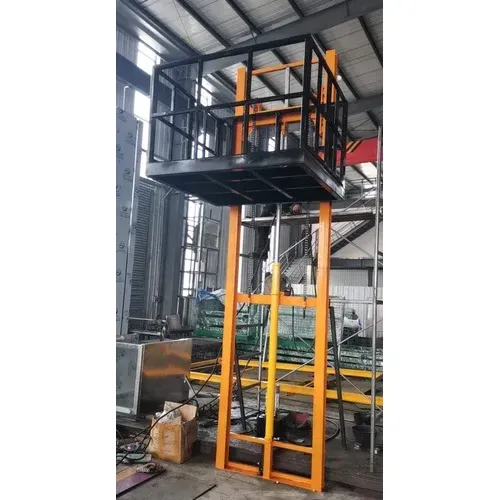Hydraulic Goods Lift: A Versatile Elevator for Heavy Lifting

Hydraulic Goods Lifts are one of the convenient heavy lifting solutions for any modern industry, streamlining the vertical movement of heavy loads. These elevators are highly versatile for carrying various types of materials across floors of the facilities. Commonly they are hired in warehouses, large distribution centers, construction sites, and manufacturing units, as a robust lifting solution to move loads vertically. Moreover, the hydraulic mechanism makes them so reliable and high-performing, ensuring high productivity and safety levels. Also, hydraulic goods lifts are customizable according to the facility layout catering specific needs of a business.
What is Hydraulic Goods Lift?
Hydraulic Goods Lift is an industrial-grade elevator with vertical movement, designed for lifting heavy loads across shelves, platforms, floors, etc. Powered by a hydraulic mechanism, it offers high performance, swift material handling, efficient and controlled lift, and ultimate safety. These elevators increase productivity levels with long working hours and less downtime. Moreover, hydraulic goods lift saves a lot of operational costs and labor expenses by automating the lifting process. Adapting to the industrial environment, this equipment facilitates various applications through vertical lifts.
How do Hydraulic Mechanisms Enhance Lifting Capabilities?
These points will help you understand the importance of hydraulic mechanisms in lifting equipment:
Hydraulic Fluid
- Utilizes hydraulic fluid to generate strong, consistent force.
- Hydraulic systems convert energy into mechanical power efficiently.
High Load Capacity
- Capable of lifting heavy loads with ease.
- Suitable for industrial applications requiring significant lifting power.
Smooth and Controlled Movement
- Provides precise control over lifting and lowering speeds.
- Ensures stable and smooth operation, reducing the risk of sudden movements.
Adjustable Speed
- Allows for variable lifting speeds to match specific operational requirements.
- Enhances flexibility in handling different types of loads.
Quiet Operation
- Operates with minimal noise compared to mechanical lifting systems.
- Contributes to a quieter and more comfortable work environment.
Compact Design
- Hydraulic components are compact, allowing for efficient use of space.
- Ideal for applications with limited installation area.
Durability and Reliability
- Built to withstand heavy-duty use and harsh industrial environments.
- Offers long-lasting performance with minimal maintenance.
Safety Features
- Equipped with safety mechanisms such as overload protection and emergency stop functions.
- Ensures safe operation for personnel and materials.
Customizability
- Hydraulic systems can be tailored to meet specific lifting needs.
- Flexible design options to suit various industrial applications.
Major Benefits of Hydraulic Goods Lifts
High Lifting Capacity and Reliability
Hydraulic goods lifts are designed to handle substantial weights, making them ideal for heavy-duty applications. Their robust construction and reliable hydraulic systems ensure consistent performance, even under demanding conditions.
Smooth and Controlled Movement
The hydraulic mechanism provides smooth and precise vertical movement, reducing the risk of damage to goods during transport. This controlled motion enhances the safety and efficiency of material handling operations.
Enhanced Safety Features
Hydraulic goods lifts come equipped with numerous safety features, including emergency stop buttons, overload protection, and safety interlocks. These features ensure safe operation and compliance with industry regulations, protecting both operators and goods.
Customizability
These lifts can be tailored to meet specific operational needs, including platform size, load capacity, and lifting height. Customization ensures that the lift integrates seamlessly into various industrial environments, enhancing overall workflow.
Cost-Effectiveness and Long-Term Savings
Investing in hydraulic goods lifts can lead to significant cost savings over time. Their efficiency reduces labor costs and minimizes downtime, while their durability ensures a long service life, reducing the need for frequent replacements or repairs.
Versatility
Hydraulic goods lifts are suitable for a wide range of applications, from warehouses and manufacturing plants to construction sites and retail environments. Their adaptability makes them valuable assets across different industries, improving overall operational efficiency.
Easy Installation and Maintenance
Hydraulic goods lifts are relatively easy to install and require minimal maintenance compared to other lifting systems. Regular, straightforward maintenance practices ensure longevity and reliable performance, reducing the total cost of ownership.
Applications of Hydraulic Goods Lift
Warehousing
Hydraulic goods lifts streamline the storage and retrieval process in warehouses by efficiently transporting heavy pallets, crates, and other bulky items between different levels. This reduces manual labor and speeds up inventory management, improving overall productivity.
Manufacturing
In manufacturing plants, hydraulic goods lifts are used to move heavy machinery, raw materials, and finished products. They facilitate smooth and safe transport within production lines, enhancing workflow efficiency and reducing the risk of injuries from manual handling.
Construction
Construction sites utilize hydraulic goods lifts to transport building materials such as bricks, cement, and steel beams to different levels. These lifts are crucial for improving site efficiency, reducing manual lifting, and ensuring timely completion of construction projects.
Retail
Retail environments benefit from hydraulic goods lifts for moving large inventories, stock, and supplies between storage areas and sales floors. This ensures quick restocking, efficient space utilization, and a seamless shopping experience for customers.
Logistics and Distribution
In logistics and distribution centers, hydraulic goods lifts enhance operations by facilitating the movement of packages, parcels, and freight between loading docks, storage areas, and sorting facilities. This optimizes the handling and processing of goods, leading to faster and more efficient delivery services.
Automotive
The automotive industry uses hydraulic goods lifts to handle heavy car parts, engines, and other components. These lifts ensure precise and safe positioning of parts during assembly, maintenance, and repair processes, improving operational efficiency and safety.
Food Processing
In food processing plants, hydraulic goods lifts are used to transport ingredients, finished food products, and packaging materials between different production stages. They maintain hygiene standards and improve the efficiency of handling bulky and heavy loads.
Pharmaceuticals
Pharmaceutical manufacturing and distribution facilities use hydraulic goods lifts to move medical supplies, equipment, and packaged drugs. These lifts help maintain clean and controlled environments, ensuring the safe and efficient transport of sensitive products.
How to Choose a High Quality Hydraulic Goods Lift For Your Facility?
Assess Your Specific Needs
Determine the exact requirements for your hydraulic goods lift by considering the types of materials you will be lifting, the maximum load capacity needed, and the lifting height. Evaluate the frequency of use and the operational environment, including indoor or outdoor settings and temperature variations.
Choose the Right Type of Lift
Select a lift that suits your specific application. Scissor lifts are ideal for high precision and stability, freight elevators are best for industrial and large-scale applications, dock lifts are suitable for loading and unloading tasks, and vertical reciprocating conveyors (VRCs) are great for multi-level material transport.
Evaluate Load Capacity and Platform Size
Ensure the lift has adequate load capacity to handle the heaviest items you plan to move. Verify that the platform size can accommodate the dimensions of your largest loads, considering oversized platforms for bulky or irregularly shaped items.
Consider Safety Features
Prioritize safety by selecting lifts with essential features such as emergency stop buttons, overload protection, safety interlocks, and guardrails or gates. These features ensure secure operation and prevent accidents during loading and unloading.
Check Durability and Build Quality
Choose a lift constructed from high-quality materials like heavy-duty steel or aluminum for longevity and reliability. Ensure the lift has a robust frame and high-quality hydraulic components to withstand heavy use and reduce maintenance needs.
Consider Ease of Installation and Maintenance
Select a lift that is straightforward to install and maintain. Look for comprehensive installation instructions and support from the manufacturer. Choose a model that allows easy access to components for routine inspections and servicing, ensuring long-term reliability.
Evaluate Manufacturer Reputation and Support
Choose a reputable manufacturer known for producing high-quality hydraulic lifts. Read customer reviews and testimonials to gauge satisfaction with the product and the manufacturer’s support services. Ensure the manufacturer offers a good warranty, responsive customer service, and reliable technical support.
Inspect Advanced Features
Look for lifts that incorporate modern technology, such as automated controls for precision and ease of use, energy-efficient motors to reduce operational costs and environmental impact, and real-time monitoring systems for enhanced operational oversight and maintenance scheduling.
Explore More:


